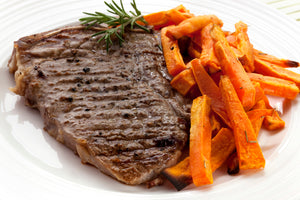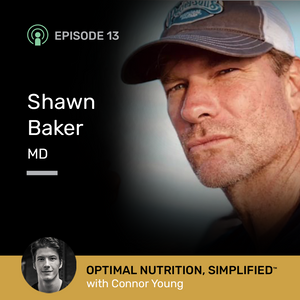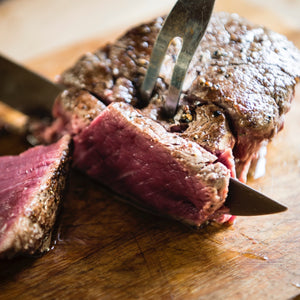Why Ample Is So Rich In Fat
By Connor Young on
Ample has four different fats in it:
Macadamia nut oil, coconut oil, chia seed oil, and sunflower lecithin
I get a lot of questions about the fats in Ample. They’re a little unusual – it’s not every day that you see macadamia nut oil, chia seed, coconut oil, and sunflower lecithin in the same product – but there’s a method to the madness. I’ll take you through my rationale.
In a nutshell, I wanted three things from the fats in Ample:
- Nutrition. That meant a spectrum of useful saturated, monounsaturated, and omega-3 fats, with very few omega-6 fats, and no artificial trans fats (by the way, you can read about the different types of fat here).
- Satiety. I wanted Ample to leave you full for a few hours. Fat plays a big role in that.
- Taste. Food is one of the great pleasures in life. I definitely didn’t want to compromise on flavor.
Here’s how I settled on macadamia nut oil, coconut oil, chia seed oil, and sunflower lecithin for Ample’s formula. Let’s start with the tastiest one: macadamia nut oil.
Macadamia nut oil for monounsaturated fats

I started off looking for a good source of monounsaturated fatty acids (affectionately known as MUFAs).
MUFAs are the happy middle child of the fat world. Your body converts them into energy well [1]. They’re relatively stable. They’re not inflammatory [2]. In short, they’re good healthy fats. MUFAs are one of the main attractions of the famous Mediterranean Diet, which links to low risk of heart disease and dementia [3].
The challenge is that many oils high in MUFAs also have lots of inflammatory omega-6 fats (more on omega-6s in a moment). I passed on most nut and seed oils because of their higher omega-6 content, and because they’re a common source of food sensitivities [4].
The three MUFA-rich oils left were macadamia, olive, and avocado.
I tried olive and avocado first. They tasted quite bitter. Then I tried macadamia nut oil. The stuff was a home run – it lent a smooth, nutty undertone to Ample’s taste. It was so good that I gave this label to the first batch that came in:

Plus, macadamia has the highest concentration of MUFAs of any natural oil [5], and it’s low in omega-6s [6]. It rocked both health profile and flavor.
To recap:
- Macadamia nut oil has lots of healthy monounsaturated fats
- It’s low in omega-6s
- It tastes awesome
Coconut oil for healthy saturated fats

Saturated fat gets a bad rap, but it’s actually quite useful for your body, provided you get it from good sources. I’d say it’s misunderstood – several recent meta-analyses suggest that overall saturated fat intake doesn’t correlate to heart disease and that the actual story is a little more nuanced [7,8]. There’s a full breakdown of saturated fats coming in the next couple weeks. For now, I’ll leave it at this: after a lot of research, I decided I wanted a good bit of saturated fat in Ample.
Coconut oil turned out to be an excellent choice. For starters, it’s about 96% saturated fat. Check.
What makes coconut oil special, though, is its comprehensive fat profile: it has short-chain, medium-chain, and long-chain fatty acids, each of which offers unique benefits (you can read up on exactly how these fats benefit your body here) [9].
Roughly half of the fat in coconut oil is lauric acid, which converts to energy quickly and is unlikely to be stored as body fat [10]. In fact, a single but well-controlled study found that coconut oil helped women lose abdominal fat, potentially because of lauric acid [11]. Your body also turns some lauric acid to monolaurin, an antibacterial, antiviral, and antifungal compound that kills pathogens without disrupting your gut bacteria [12].
In short, I chose coconut oil because:
- It has a variety of beneficial fats.
- You metabolize it into energy quickly and fully.
And coconut oil tastes great. It’s a win all around.
Chia seed oil for omega-3s

You’ve probably heard about how awesome omega-3s are for you. They’re the “good” fats, largely because they balance out inflammatory omega-6s that hide in so many processed foods these days. Eating an even ratio of omega-3 to omega-6 correlates with a longer, healthier life [14].
You may also have heard that one of the best sources of omega-3s is fish oil. It provides all three types of omega-3: ALA, EPA, and DHA. Unfortunately, fish oil tastes…well, fishy. I tried adding fish oil to Ample. It was horrifying.
Chia seed oil, on the other hand, tastes fine, but its nutrient profile isn’t as impressive. It has plenty of ALA, but not much EPA or DHA. And EPA and DHA are more useful – your body can only use about 4-6% of the ALA you eat [15]. So basically, chia seed oil gives you a modest dose of omega-3s.
Chia seed oil also has a wealth of antioxidants and polyphenols [16]. There’s some evidence that the most prominent ones, chlorogenic acids, may protect against diabetes and calm inflammation [17].
What’s clearer is that chia seed oil’s antioxidants keep fats very stable [18], which is good news for Ample; it means the fats you’ve been reading about won’t degrade as your Ample sits on the shelf, and there’s no need for artificial preservatives.
Ample is pretty damn good, but I’m always working on making it better. One way I want to do that is by adding more EPA and DHA. I just have to find a source that doesn’t turn Ample into a fish smoothie.
In the meantime, you can make sure you’re getting plenty of omega-3s by taking a good fish oil supplement (algae oil is great if you’re vegan), or by eating wild fatty fish like salmon.
Quick recap:
- Chia seed oil has some omega-3s, mostly in the form of ALA.
- Fish oil is a better source of omega-3s, but it also makes Ample taste like a fish smoothie.
- I’m looking for a non-fishy omega-3 source.
- The antioxidants in chia seed oil keep Ample’s nutrients from breaking down, and may be good for you in their own right.
Sunflower lecithin for omega-6s and choline

Sunflower seeds contain an omega-6 called linoleic acid. It’s an essential fatty acid, meaning you need it to function and your body can’t produce it on its own, so you have to get it from food.
Linoleic acid is great for you … as long as you’re only getting a small amount of it. That’s why there’s not too much sunflower lecithin in Ample – I wanted enough to create a balanced meal, but not so much that it screws up your omega-3 to omega-6 ratio.
The other cool thing about sunflower lecithin? It’s an emulsifier. That means it attracts both liquids and fats and keeps them together. Sunflower lecithin is the reason your bottle of Ample blends into a nice creamy consistency, instead of turning into a separated mess of water, oils, and starches as soon as you shake it up.
Sunflower lecithin is also a stellar source of choline, which keeps your nerves, muscles, and brain functioning [16], helps your liver break down fat, and may keep your heart strong [17].
Summing up:
- Sunflower lecithin has a balanced amount of linoleic acid, an essential omega-6 fat
- It keeps Ample’s consistency creamy
- It has lots of choline, which keeps your brain running smoothly (By the way, egg yolks are another awesome source of choline)
Enjoy your healthy fats
My goal with Ample was a comprehensive, nutritious meal on the go. I wanted to make sure each bottle has a full spectrum of fatty acids and enough fat to satisfy, without skimping on deliciousness. I hope it works well for you.
I didn’t want to get too crazy into the science here, but if this article got you excited about fats, check out this deeper dive into how fats work. And please, leave any insights or questions in the comments below. I’m always happy to talk more about the science behind this stuff.
In good health,
Connor
← Older Post Newer Post →





